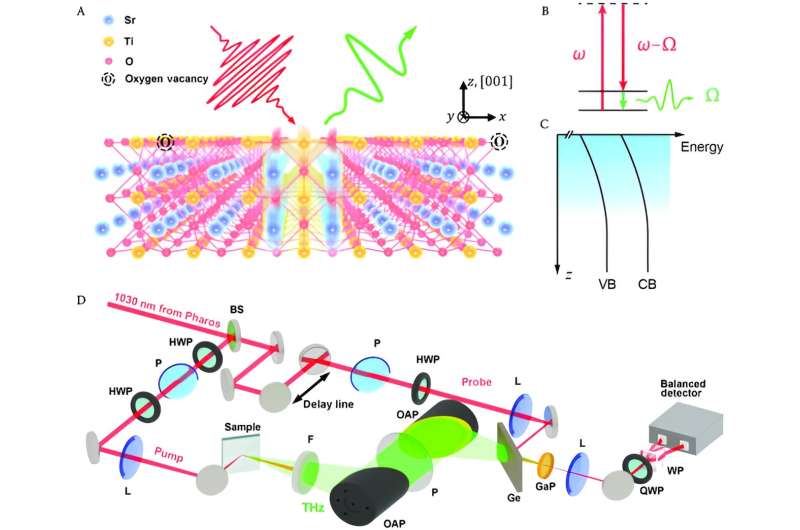This article has been reviewed according to Science X's editorial process and policies. Editors have highlighted the following attributes while ensuring the content's credibility:
fact-checked
proofread
Surface-specific nonlinear optical spectroscopy comes into terahertz range

Second order surface-specific nonlinear optical spectroscopy, e.g. sum-frequency spectroscopy, has made significant and continuous success in revealing the microscopic structures at surfaces/interfaces since the 1990s.
However, its spectral range has long been limited to Vis—mid-IR (> 20THz). While in terahertz range, it happens to be greatly important for lattice (or molecular) vibrations, quasi-particles, and elementary excitations of many materials. In this range sum-frequency generation is no longer valid due to the lack of an intense terahertz source. Even if a powerful terahertz pulse was available, it is impossible to extract the weak sum-frequency signal from the huge visible pump light because the two essentially degenerate in frequency.
Recently, a research team from Fudan University, University of California, Berkeley and ShanghaiTech University reported a new approach to extend the surface-specific nonlinear optical spectroscopy into the terahertz region by using the intra-pulse difference frequency mixing (DFM) process with detection sensitivity as good as sub-monolayer.
Contrary to the well-established sum-frequency spectroscopy (SFS), difference frequency spectroscopy (DFS) has obvious advantage over SFS in terahertz range for its free of requirement on intense terahertz source and the large frequency spacing between terahertz signal and pump light making it easy for detection.
The research team used a femtosecond pulse as pump and measured the THz emission by state-of-the-art electro-optic sampling detection scheme, which can achieve submonolayer sensitivity. As a demonstration, SrTiO3(001) surface was studied for its multifunctional nature and the uniqueness in fabrication and modification with atomic-level precision.
It was shown that the polarized phonon modes located at the surface or interface of SrTiO3(001) can be characterized using surface-specific nonlinear terahertz spectroscopy. Via symmetry analysis and proper polarization selection, the research team can selectively probe the polarized phonon of SrTiO3(001) or the Drude-like nonlinear response from the two-dimensional electron gas at LaAlO3/SrTiO3 and Al2O3/SrTiO3 interface.
From quantitative THz spectrum analyzation, the research team developed an optical protocol for remote measurement of the interfacial potential of complex oxides in non-vacuum or buried condition.
In summary, terahertz DFS offers new opportunities for in situ studies of the low-frequency excitations at interfaces of complex oxides heterostructures. The capability of resolving the low-frequency collective excitations at surface or interface with monolayer sensitivity also can be readily extended to multi-disciplines, such as the surface structure of the hydrogen-bond network, the frustrated vibration of physisorbed species on metal oxides in catalytic reactions, etc.
The work is published in the journal Ultrafast Science.
More information: Yudan Su et al, Probing Interface of Perovskite Oxide Using Surface-Specific Terahertz Spectroscopy, Ultrafast Science (2023). DOI: 10.34133/ultrafastscience.0042
Provided by Ultrafast Science





















